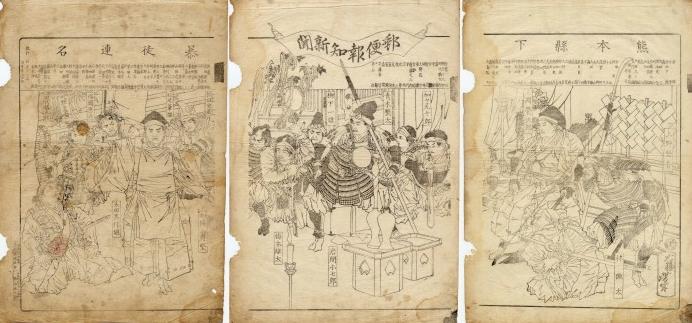Commentary
The Kumamoto rebels named in the list were members of Shinpūren" (神風連) or "Divine wind alliance". The party equated itself with the gods who had guarded Japan over the ages and protected it from Mongol invasions during the 13th century.
The Shinpuren rebellion (神風連の乱 Shinpuren no ran) -- sometimes called the Keishinto rebellion (敬神党の乱 Keishinto no ran) -- took place on 24-25 October 1876. The triptych is a memorial to the deaths of party members who were killed during the rebellion, or who killed themselves afterwards.
While the drawing appears to glorify the rebels, calling them "boto" (rioters) would seem to diminish their glory. But such expressions seem to have cliches on a par with calling Robin Hood a "robber" while admiring the hero of Sherwood Forest.
Here the publisher and Yoshitoshi, who understand the commercial value of stories about dying for a cause, are probably calling the party members "boto" -- in deference to the government's condemnation of the rebels -- in order to disarm critics who might otherwise have questioned their memorialization of the rebels and even their slogans -- as though to say the intentions of the rebels, if not their acts, had been honorable.
A number of books have been written about the Shinpuren in Japanese. In best article in English is John M. Rogers, "Divine Destruction: The Shinpuren Rebellion of 1876", in New Directions in the Study of Meiji Japan (Leiden: E.J. Brill, 1997), which can be read on Google Books.
Related prints
Similar name lists appear on other prints. Yamaguchi rebels pursued (THS-9005) disclosed the names of some of the dissidents involved in the Hagi rebellion, which followed the Shinpuren rebellion by just a few days.
The Shinpuren rebellion was also the theme of Shinpuren rebellion (YHS-1127), which features Ueno Kengo in action on a brown horse. Whereas Yoshimura's Kumamoto rebels defeated (TNS-9004) shows him on a white horse.
Print information
Series: Yubin hochi shinbun
Issue: No issue number [YHS-9001]
Series number: No series number
Date: Meiji 10-2-?? [1877-2-??] (otodoke)
Publisher: Kumagaya Shoshichi [Kinshodo]
Drawer: Tsukioka Yonejiro
Signed: Taiso Yoshitoshi
Carver: Unsigned
Writer: Unsigned
Price: Not stated
Size: Oban triptych
Image: University of Tokyo (Tsuchiya 2000)
Principal sources
Tsuchiya 2000
CCMA 2008
